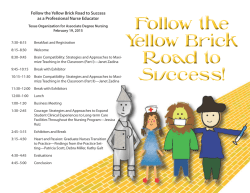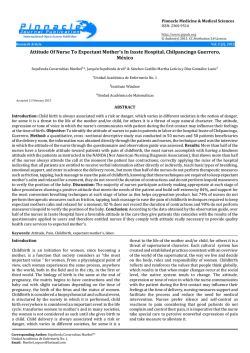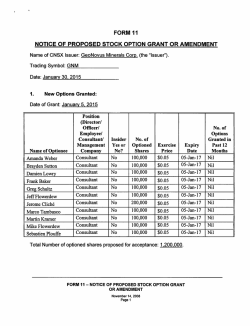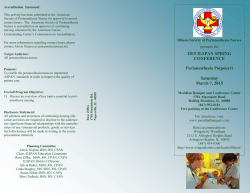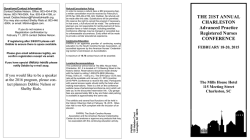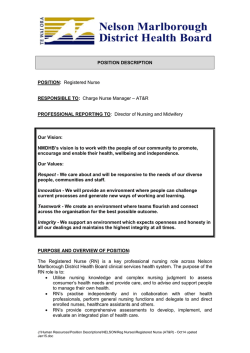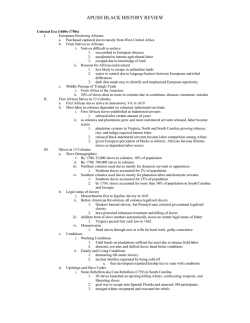
APUSH Women Review
APUSH WOMEN REVIEW Colonial Era (1600s-1750s) Pocahontas and Jamestown Limited arrival of women in early colonial establishments Massachusetts Bay Colony o Anne Hutchinson banished for antinomianism (1638) o Salem Witch Trials (1692) targeted mostly women majority of Church membership was female women responsible for housekeeping and childrearing while men labored on farms women subordinate to men o serve father when single then husband when married o protections from spousal abuse stigma against older single women and unmarried widows no right to vote, own property, draft a will, testify in court o women could inherit property upon death of husband, but lost rights once remarried o some northern cities/colonies provided women the right to vote in limited cases o southern colonies established and preserved strict patriarchal society Revolution and Early Republic (1750s-1820s) upper-class patriot women assist independence movement o spinning bees women served war as nurses, water bearers, cooks o Molly Pitcher legend Abigail Adams o “remember the ladies” in drafting new constitution “all MEN created equal” in Declaration of Independence No formal recognition for women in U.S. Constitution after U.S. Constitution, most states removed right to vote for women o New Jersey only state to provide suffrage for women REPUBLICAN MOTHERHOOD o Women educated on republican virtues to pass to children to grow up as responsible American citizens o Academies for women established to develop civic duty as republican mothers Judith Sargent Murray – On the Equality of the Sexes (1790) o Promote continued education for women beyond republican motherhood Sacagawea assisted Lewis and Clark Expedition (1804-1806) Early economic conditions required more from women in terms of labor outside of the house o Assisted husbands on farms especially among lower-class families o Cottage system/putting-out system – spinning/weaving Form of subcontracting domestic services in textile market Women and War of 1812 o Served as nurses o Dolly Madison and Washington’s portrait Troy Female Seminary (1821) o Established by Emma Hart Willard in New York o Provided women an equal college education as men received APUSH WOMEN REVIEW Age of Jackson to Civil War (1820s-1860s) Universal male suffrage opened up electorate, but women left out CULT OF DOMESTICITY o After economic conditions improved through the market revolution and transportation booms, women were not required to work on the fields as before o Increased factory jobs for men placed increased homemaking and childrearing burdens on women o Defined and established women roles as homemakers and wives/mothers o Any jobs for women were domestic-based such as textiles Middle Class Women Worked as sales clerks, teachers Working Class Women Worked at home with sewing/spinning Worked as domestic servants for upper-class families o Lowell System Single young women provided textile mill labor Lived free in boardinghouses next to textile mills Strict moral code and regiment, but provided chaperoned social activities and cultural education Frontier life for Women o Frontier life began under sense of cult of domesticity o Rugged lifestyle of frontier demanded more of women to serve beyond domestic capacities o Some women established boardinghouses and hotels out West Benevolent and Reform Movements o Dorothea Dix Concern for mentally ill led to reforms in asylums and prisons o Temperance movement Mostly led by middle-class women to alleviate society of alcohol vice o Female Moral Reform Society Reforms or enforcement toward prostitution o Abolitionist Movement Maria Stewart Black woman who wrote essays and gave public speeches on abolitionism in 1830s Sarah and Angelina Grimke Led abolitionist rhetoric with first-hand experiences as women living on plantations in South Carolina Also spoke about woman equality/suffrage Female Anti-Slavery Society (1832) Free black women in Salem, MA establish nation’s first female-based abolitionist society Harriet Tubman Escaped slave who helped free slaves through underground railroad in 1850s Harriet Beecher Stowe and Uncle Tom’s Cabin (1852) Reality-based anti-slavery novel spurred northern sentiment against slavery in the South o Women’s Rights Movement Elizabeth Cady Stanton, Lucretia Mott, Susan B. Anthony, Sojourner Truth Seneca Falls Convention (1848) Declaration of Rights and Sentiments of Women Sojourner Truth – Ain’t I a Woman? (1851) Speech against female weakness as perceived by male dominance Comparisons to hardships as a slave Women and the Civil War o Served as nurses for Union and Confederacy o Some minor cases of women involved in skirmishes and raids o Dr. Mary Edwards Walker awarded Medal of Honor for Union espionage and surgeon duties APUSH WOMEN REVIEW Gilded Age and Progressive Era (1860s-1920) Industrialization and urbanization effect on women’s roles o If economically feasible for families, cult of domesticity accepted by men and women o Mechanization reduced need for women and children on farms o Urban conditions reduced families decreasing women roles as caretaker/mother o Increased and newer industries allowed increased factory job opportunities for women Limited to domestic industries, i.e. textiles, spinning mills As men assumed managerial positions, women assumed previously male-based professional jobs Clerks, bookkeepers, typists, secretaries, telephone operators o Because women worked in newer positions, status and wages lowered than previously held/paid with men o 20% of adult women in labor force by 1900 Most young women; only 5% married women o Divorce rates increased to 1 in 12 marriages by 1900 States granting more divorce rights for abuse and desertion Second Industrial Revolution and corporations/monopolies form during Gilded Age leading to unfair and deplorable working and living conditions o Owners sometimes hired women as cheap labor for profits given unequal wages o Middle-class women pursued reforms through Social Gospel Settlement houses – Jane Addams and Hull House in Chicago (1889) Community centers providing daycares, schooling, cultural activities English lessons for immigrants, child-care classes Addams won Nobel Peace Prize in 1931 Temperance Movement o Woman’s Christian Temperance Union (1874) Lobbied for local/state laws against alcohol Frances E. Willard o Carrie A. Nation destroyed bars across the nation Mary Baker Eddy and Christian Science o Good health result of “Father Mother God”` Ida Tarbell and The History of the Standard Oil Company (1902) o Muckraker articles on ruthless business exploits of John D. Rockefeller Women’s Suffrage/Rights Movement o Susan B. Anthony, Elizabeth Cady Stanton, Victoria Woodhull, Lucy Stone, Julia Ward Howe, Alice Paul o Despite Progressive Era reforms surging in many aspects, women suffrage and rights was slow and gradual o National Woman Suffrage Association (1869) o American Suffrage Association pursued woman suffrage in state constitutions o Equal Rights Party nominated Victoria Woodhull first ever female presidential candidate in 1872 o Jeannette Rankin (R-Montana) – first woman elected to Congress in 1917 o National American Woman Suffrage Association (1890) Many gains for suffrage in states, especially in the West Wyoming – first state granting full woman suffrage in 1869 Carrie Chapman Catt pursued woman suffrage on national level with constitutional amendment o National Woman’s Party – Alice Paul and Lucy Burns (1916) More militant strategies: picketing, parades, hunger strikes Silent Sentinels pressuring Woodrow Wilson o Nineteenth Amendment (1920) – female suffrage Led to League of Women Voters by Chapman World War I Effects o First American war women officially allowed to serve in military, mostly as nurses or operators o Men drafted opened up jobs for women o Woman contributions to war effort helped support Nineteenth Amendment o Women returned to previous status after war; not allowed to serve in military unless nurses APUSH WOMEN REVIEW Roaring Twenties to World War II (1920-1940s) Suffrage’s Limited Impact on Women o Women voted like their husbands o Politicians campaigned for women issues Increased divorce laws and protections 1 in 8 marriages divorced in 1920 1 in 6 marriages divorced in 1930 o Equal Rights Amendment introduced in Congress in 1923; never passes…until… o Compulsory education for females led to opportunities for higher education Feminism of 1920s o Flapper Girls Rejection of conservatism, Victorian society norms Smoked, drank, swore, danced, dated, promiscuous, consumerist, purchased cosmetics Short skirts, bobbed hair; prefer slender bodies/image o Margaret Sanger American Birth Control League (1921) Promote education for pregnancy prevention, menstruation Spoke against poor conditions for young women Women and the Depression o Unemployment rate for women lower than men in 1930s Women paid less than men Men unwilling to accept “women jobs” like clerical or domestic service o Depression decreased professional opportunities for women o Severe burdens on women as husbands/fathers left homes looking for employment o Eleanor Roosevelt becomes vocal and strong First Lady and promotes many social issues o Frances Perkins appointed Secretary of Labor in 1933 – first female in Cabinet o Amelia Earhart’s flights from 1932-1937 World War II’s Impact on Women o Drafted men allowed women to assume more jobs in factories 12 million women in workforce in 1941 to 18 million by 1945 Rosie the Riveter o 350,000 women in military serving as nurses, operators, loaders, mixers, mechanics, electricians, spies APUSH WOMEN REVIEW Post-World War II (1950s-1980s) Women replaced by men once war was over o Some lower-class/working-class women returned to old jobs cult of domesticity emphasized as economy prospered in 1950s o baby boom from 1945-1960 o television and consumer society promoted women in image of housewife/homemaker and subservience o 46% women in workforce, but 75% clerical or sales jobs 1950s women earned 60% of men’s salaries Rosa Parks inspired Montgomery Bus Boycott in 1955 o Browder v. Gayle desegregated busing (1955) Equal Rights Movement for Women and Feminism o Studies and books published for reviewing or criticizing unequal opportunities for women o President Kennedy’s Commission on the Status of Women (1961-1963) Found inequality and discrimination in education, employment, and political rights o Betty Friedan and The Feminine Mystique (1963) Criticized cult of domesticity and housewife perception enlightening women on possibilities of professional opportunities beyond domestic capacities o National Organization for Women (1966) Pursue equal and full opportunities for women, especially in the workplace o Equal Employment Opportunity Act of 1972 Equal Employment Opportunity Commission may sue for discrimination in workplace based on gender o Title IX in Education (1972) Gender equity in federally-funded educational programs More opportunities for female participation, but eliminated male-based programs/sports o Equal Rights Amendment (ERA) - 1972 First introduced by Alice Paul in 1923 Passed Congress, but only received 35 states of required 38 for ratification Mostly southern states denied ratification growing conservative culture campaigned against ERA Phyllis Schlafly argued denial of husband support, women in combat, abortion rights upheld Roe v. Wade (1973) o Supreme Court legalized abortion protecting privacy rights for women o Instilled controversial debate between pro-life and pro-choice Sandra Day O’Connor confirmed as first woman on Supreme Court (1981) Geraldine Ferraro first major party vice presidential candidate for Democrats (1984)
© Copyright 2025

